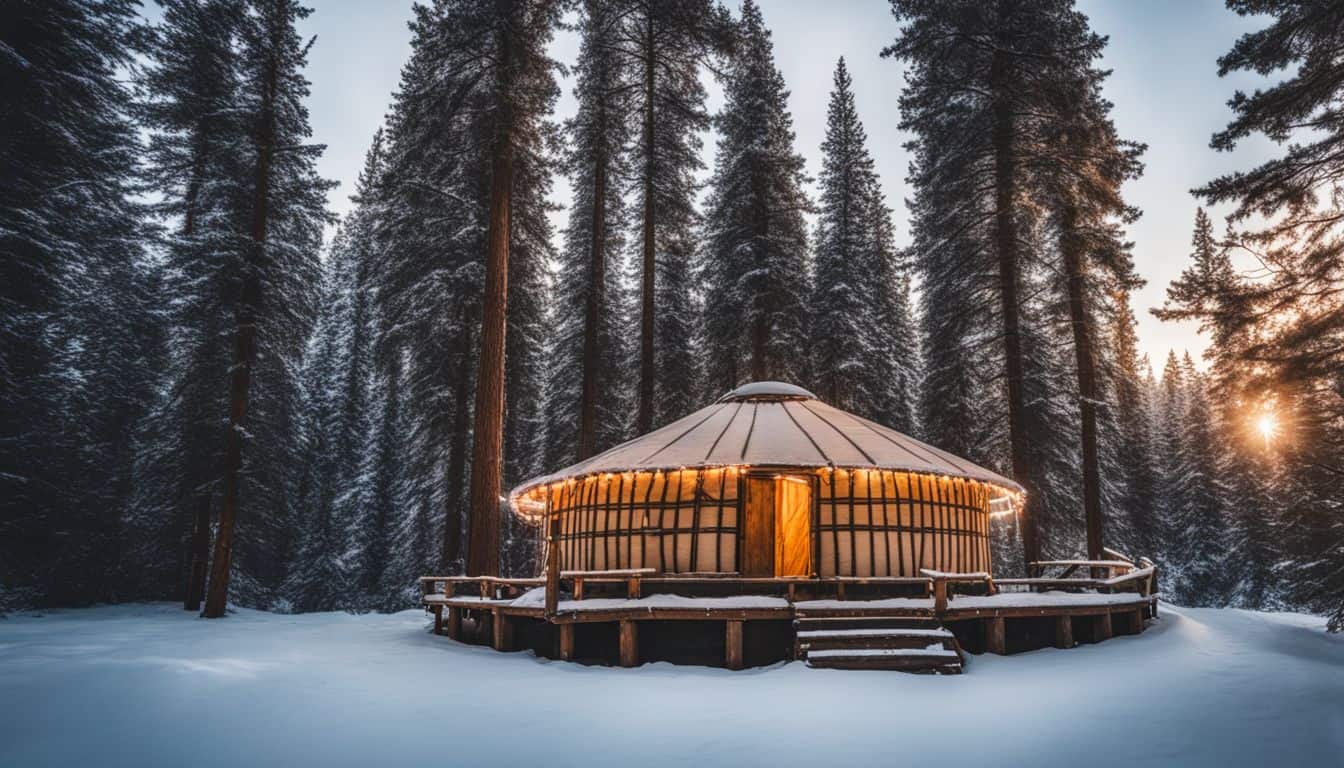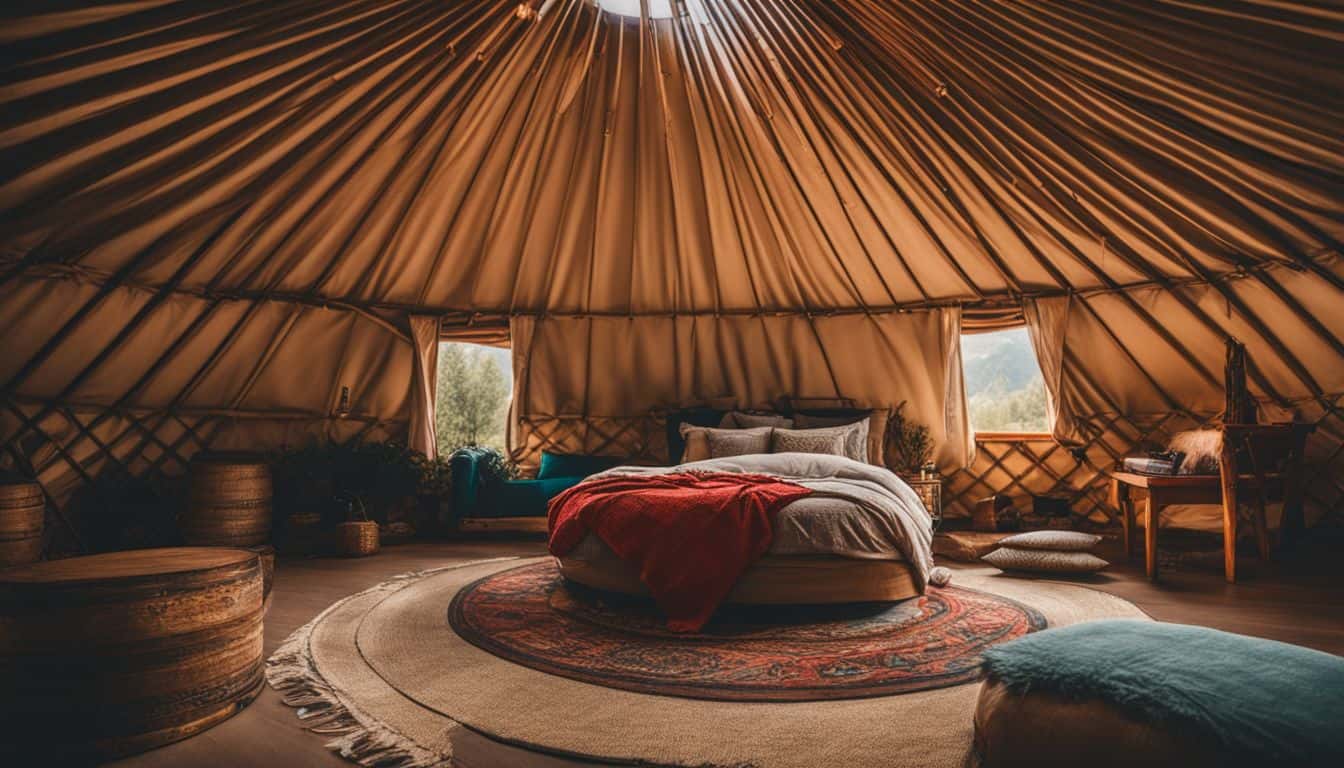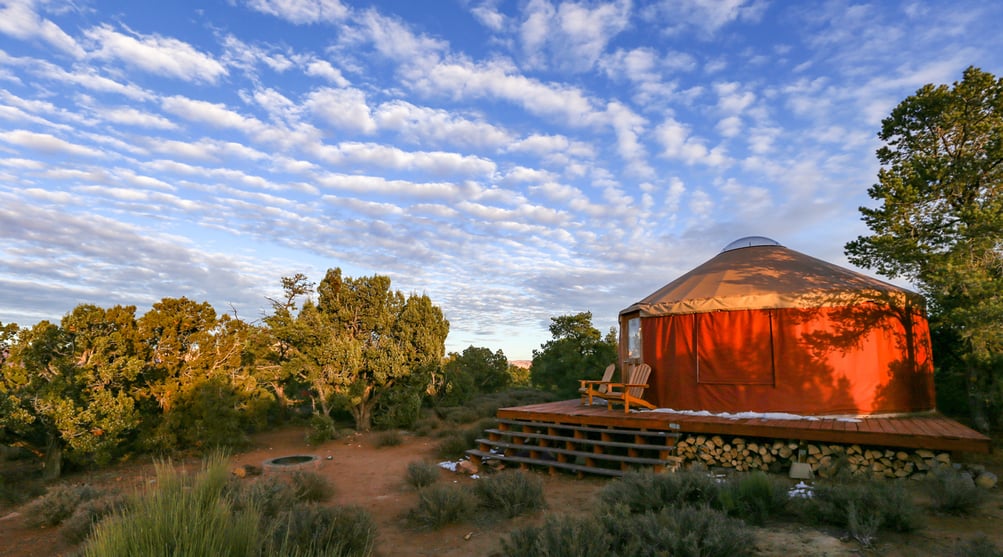Yurts have become increasingly popular as versatile living spaces, whether for remote work or as unique homes. When selecting a yurt, it’s crucial to consider your specific climate and location to ensure comfort and longevity. Here’s a comprehensive guide to help you make the right choice.
Types of Yurts
There are two main types of yurts to consider, each with its own set of advantages and ideal use cases:
Fabric yurts
These are more portable, affordable, and suitable for mild climates. They’re great for those who want flexibility in location. Fabric yurts typically consist of a lightweight frame covered with durable, weather-resistant fabric.
They can be easily assembled and disassembled, making them perfect for temporary setups or for those who like to change locations frequently. While they may not offer as much insulation as wooden yurts, modern fabric yurts often come with insulation options that can make them suitable for a wider range of climates.
Wooden yurts
More durable and better insulated, these are ideal for extreme temperatures and permanent setups. Wooden yurts are essentially solid structures that maintain the circular shape and design principles of traditional yurts.
They offer superior insulation and can withstand harsh weather conditions, making them suitable for year-round living in various climates. While they lack the portability of fabric yurts, they provide a more home-like feel and can often be customized with features like built-in furniture and advanced electrical and plumbing systems.
| Feature | Fabric Yurts | Wooden Yurts |
|---|---|---|
| Portability | Highly portable, easy to dismantle and transport | More permanent, challenging to move once installed |
| Cost | More affordable, with a lower initial investment required | Generally more expensive due to materials and construction |
| Insulation | Offers less insulation, better suited for moderate climates | Excellent insulation options, ideal for extreme temperatures |
| Assembly | Quicker to set up, often with simpler construction requirements | Takes longer to assemble, may require professional help |
| Durability | Less durable than wooden yurts, may require more maintenance | Robust and long-lasting, stands up better against harsh elements |
| Climate Suitability | Better for seasonal use or in areas with mild weather | Designed to withstand year-round living, even in colder regions |
Seasonal Considerations
Your local climate will greatly influence your yurt choice:
Summer yurts
In warmer regions, opt for lighter materials and designs that prioritize ventilation and breathability. Summer yurts often feature large windows and doors that can be opened to allow for maximum air circulation.
Some may include built-in shade structures or awnings to help keep the interior cool. The covering material is typically lighter in color to reflect sunlight and reduce heat absorption. Additionally, summer yurts might incorporate features like ceiling fans or even air conditioning units for extreme heat.
Winter yurts
For colder areas, choose well-insulated yurts with thicker fabrics that can withstand snow loads. Winter yurts are designed with extra insulation in the walls, floor, and roof to retain heat. They often have smaller, double-paned windows to minimize heat loss.
The covering material is usually heavier and may include multiple layers for added insulation. Some winter yurts come with built-in wood stoves or other heating systems. The roof is typically steeper to shed snow more easily, and the structure is reinforced to handle the additional weight of snow accumulation.

| Feature | Summer Yurts | Winter Yurts |
|---|---|---|
| Insulation | Lighter materials; designed for breathability to prevent overheating | Arctic Insulation; well-insulated subfloor to retain heat |
| Materials | Fabrics that reflect sunlight | Thicker, more durable fabrics to withstand snow loads |
| Ventilation | Larger windows or air vents to maximize airflow | Double-paned windows; controlled venting to minimize heat loss |
| Heating/Cooling Systems | Portable fans or air conditioning units | Wood stoves or radiant floor heating |
| Flooring Options | Cooler materials like laminate | Carpeting or thermal flooring for added warmth |
| Doors and Windows | Screen doors for insect protection and ventilation | Insulated doors and storm windows for added warmth and protection |
| Additional Considerations | Shade structures or awnings for cooling | Snow and wind load reinforcements |
Key Factors to Consider
When choosing the right yurt, keep these factors in mind:
- Budget: Consider not just the yurt cost, but also expenses for foundations and utilities. Factor in additional costs like insulation, heating/cooling systems, and potential site preparation. Don’t forget to budget for furnishings and any custom features you might want.
- Size and Type: Base your choice on the number of occupants, intended use, and available space. Consider future needs as well – will your family grow or will you need extra space for hobbies or work? Remember that different yurt sizes can affect heating and cooling efficiency.
- Weather Conditions: Select materials and designs suitable for your local climate. For areas with heavy snowfall, choose a yurt with a steeper roof pitch. In hot climates, opt for lighter colors and materials with good ventilation properties.
- Zoning and Building Regulations: Always check local laws and obtain necessary permits. Some areas may have specific requirements for permanent structures, so ensure your yurt design complies with local building codes. You may need to provide detailed plans or hire a professional to help navigate the permitting process.
Site Selection Tips
The location of your yurt is crucial:
- Choose a spot with appropriate weather conditions (e.g., shade for hot climates, wind protection for cold areas). Consider the sun’s path throughout the day and seasons. Natural features like trees or hills can provide valuable protection from elements.
- Consider the view and accessibility of the site. Think about how you’ll access utilities and whether you’ll need to create a driveway or path. A beautiful view can enhance your yurt living experience, but balance this with practical considerations like privacy and proximity to amenities.
- Ensure proper drainage and foundation options. Poor drainage can lead to moisture problems and foundation issues. Consider elevated platforms in areas prone to flooding or heavy rainfall. Consult with local experts about the best foundation type for your specific site conditions.

Maintenance Considerations
Maintaining and caring for your yurt will vary depending on your climate and location:
- In humid areas, focus on mold prevention. This might include regular inspections, using dehumidifiers, and ensuring proper ventilation. Consider treating fabric components with mold-resistant solutions.
- In sunny regions, prioritize UV protection for the yurt materials. This could involve applying UV-resistant coatings or choosing materials specifically designed to withstand intense sunlight. Regular inspection of the outer covering for signs of UV damage is crucial.
- In all climates, establish a regular maintenance schedule. This should include checking tension cables, inspecting the roof for any damage, and ensuring all zippers and fastenings are in good condition. Seasonal maintenance tasks, like preparing for winter or summer, can help prolong the life of your yurt and ensure it remains comfortable year-round.
Conclusion
Remember, the key to a successful yurt experience is matching it to your specific climate and location needs. Once you’ve chosen the perfect yurt, don’t forget to make it your own with some creative yurt interior design ideas.
By carefully considering these factors, you’ll be well on your way to choosing a yurt that provides comfort, durability, and enjoyment for years to come.

Leave a Reply